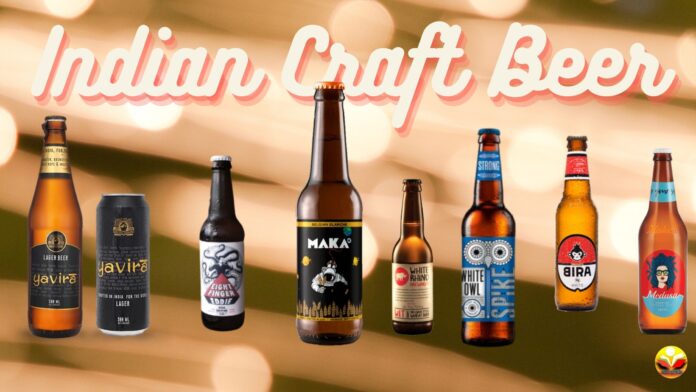India’s alcohol market is the world’s third-largest and fastest-growing. According to a recent Euromonitor survey, it is projected to expand by 25% to $41 billion by 2022. Beer, wine, and spirits are the three major types of alcoholic beverages available. After whiskey, beer is India’s second most popular alcoholic beverage. It comprises of market share of 2-3 percent of India’s beer market ($7 billion) compared to 12 percent in the US, the decade-old Indian craft beer industry is still in its infancy.
According to the All-India Brewers Association, craft beer sales are expected to increase by 20% y-o-y, which is higher than the beer market’s 5-7 percent y-o-y rise. Over 30% of India’s population lives in urban areas, which have seen steady growth in restaurants, bars, and brewpubs, a more recent phenomenon. Craft beer’s popularity is fueled by millennials who prefer it to standard lagers because it is more authentic and premium.
Traditional beer in India has been made for thousands of years from rice or millet. The British brought European beer to India in the 18th century. Stronger alcoholic drinks, such as whisky, are more common than beer. Strong beers are the most common in India. Indian beer is not only available in Bottle but also Indian Beer Can is very much acceptable by the young generation.
What distinguishes craft beer from other brews?
Unlike large-scale beers, these craft brews are made in small batches using carefully curated recipes rather than formulas. As a result, the word “art” was coined.
Aside from making a lot of money, some have a far higher goal in mind: empowering local communities and conserving natural resources.
KHAJURAHO BEER
Lilasons Breweries in Madhya Pradesh is known for their strong beer brand Khajuraho, established in 1969. It is regarded as India’s first super-strong beer brand. This underappreciated beer brand will pique your curiosity with its labels depicting the mysterious Khajuraho monuments. This pale golden beer has a sweetish flavor and is available in two varieties: Super Strong (8.5-9 percent) and Lite (4.5 percent). This beer is perfect for a hot day when you want a cold beer to go with your carnivore snacks. This is considered to be one of the best Indian beer by the mass.
Ingredients: Water, brewer’s yeast, grains, starch, malted barley
SIMBA BEER
Simba Stout is a rich craft beer with traces of toffee and dark chocolate that hails from Chhattisgarh. It is considered among the top Indian beer brands. This premium-segment craft beer brand based in Durg, Chhattisgarh, that produces its beer at their flagship, state-of-the-art brewery. Simba Wit, a Belgian Wit-style beer with citrusy notes and slight hints of lemongrass, is their best-selling beer, although their lagers are available in solid and light versions.
Simba Stout is India’s first bottled stout, a low-bitterness beer with coffee notes, toffee, caramel, and dark chocolate.
Ingredients: Water, malted barley, yeast, grains, starch, hops
SIMBA LIGHT BEER
One of India’s rare stouts, Simba is a microbrewery in New Delhi. A dark beer with a thin head that pours quickly. Chocolate, roasted malt, and roasted caramel are present on the nose. Dark caramel, a touch of cocoa, malt, very soft caramel, a taste of dark espresso, with a finish of some, some sweet caramel—one of India’s best beers these days. Simba Light is a clear golden yellow pour with a tiny white head. The scent is mildly grassy and toasted malty, bitter with a hint of herbal. With an odd lemon flavour? With a dry, bitter hop finish. It is a very popular Indian beer brand.

Ingredients: Water, malted barley, yeast, grains, starch, hops
Medusa Beer
Medusa Beverages is a craft beer company that began operations in 2017. Delhi, Punjab, Uttar Pradesh, and Chhattisgarh are all home to the brand.
 This results in a mild-tasting beer with a powerful kick, close to Budweiser Magnum and Carlsberg Elephant beers. Medusa has proven to be a direct competitor of even the best available international strong beer brands in the country, with a price tag of INR 100. Medusa beer has the ability to leave a lasting impression on the customer. It’s the perfect brew for creating a fun, light-hearted atmosphere because of the energy and enthusiasm that goes into its development. The finest and freshest ingredients get used to preparing Medusa beer.
This results in a mild-tasting beer with a powerful kick, close to Budweiser Magnum and Carlsberg Elephant beers. Medusa has proven to be a direct competitor of even the best available international strong beer brands in the country, with a price tag of INR 100. Medusa beer has the ability to leave a lasting impression on the customer. It’s the perfect brew for creating a fun, light-hearted atmosphere because of the energy and enthusiasm that goes into its development. The finest and freshest ingredients get used to preparing Medusa beer.
Ingredients: Water, malted barley, brewer’s yeast, grains, hops
EIGHT FINGER EDDIE BEER
The most well-known beer from Goa Brewing Co. is Eight Finger Eddie. Goa Brewing Co.’s microbrewery, housed in a 250-year-old sprawling Indo-Portuguese mansion, is an intriguing space (in pre-pandemic times, you could take a brewery tour). Eight Finger Eddie, an aggressively hoppy oat cream IPA that pays homage to the free-spirited hippie movement of the 1960s, is their most well-known beer.

A crisp Wheat Ale and the fruity, summer-perfect Pineapple Saison are available seasonally at the brewery. Their two limited releases have also been well received, with Saint & Sinner, a Trappist-style dark ale, being our favourite.
Ingredients: Water, malted barley, brewer’s yeast, grains, starch, hops
ZESTY AMBER BEER
Kati Patang’s millennial-focused brews are made with Himalayan spring water and have an Indian twist. Zesty Amber, a beer made with all-natural malts and aromatic hops, was released in 2018 by the Delhi-based company, giving it an intense complexity and a smooth caramel finish. Their Snappy Wheat has a subtle finish of Indian spices like peppercorn, coriander, ginger, and turmeric, as well as lemon rind flavours. Saffron Lager, a light-bodied and crisp beer with hints of Saffron from Pampore, Kashmir, is their newest release.

Ingredients: Water, malted barley, yeast, grains, starch, hops
BEE YOUNG BEER(YAVIRA BEER)
Kimaya Himalayan Beverages, another Himalayan-sourced Indian beer company, debuted in September 2019 with two craft beers. Bee Young (7.2 ABV) is India’s first crafted strong beer, a crisp, clean drink with punchy citrus flavours, while Yavira (Sanskrit for beer) is a Basmati pilsner made with premium rice grains that is well-balanced, aromatic, and creamy. The beers come in 500ml bottles, allowing to drink smoothly.

Ingredients: Water, brewer’s yeast, grains, starch, malted barley
MAKA DI BEER
Goa-based Latambarcem Brewers debuted MAKA di (Konkani for “giving me”) in October 2020, making it a relatively recent entrant on the craft beer scene. The Belgian Tripel, an aromatic bespoke beer made exclusively for India in collaboration with Lupulus Brewery in Belgium, Honey Ale with honey obtained from Jim Corbett National Park, and Belgian Blanche, which is dripping with citrus notes and topped with fresh coriander and a bit of cumin, are among the four variants available. Their Bavarian Keller is an intriguing unfiltered beer made by the 1516 Bavarian Purity Law, which allows only water, hops, malts, and yeast to be used in the brewing process.

Ingredients: Water, malted barley, brewer’s yeast, grains, starch, hops
BULLET BEER
Rajasthan’s Bullet,this local brewski comes with significant health alerts all over it, with a firm bitterness, grainy hops, and a skunky fragrance to go along with its golden complexion;
Ingredients: Water, malted barley, yeast, grains, starch, hops
THE PALE ALE BEER
The Pale Ale, which was just launched, is a well-balanced, easy-to-drink beer with low bitterness. Indian pale ale beer was launched by White Rhino Brewing Co. The Indian Brewing company, founded in 2016, owns and operates a cutting-edge brewing facility in Gwalior, Madhya Pradesh, from which it distributes to domestic and international markets (Nepal and the United Kingdom). White Rhino Wit, a Belgian Witbier brewed with organic coriander and Curacao orange peel. This wheat beer is made with Indian rolled wheat and fresh organic coriander seeds from the Himalayas, rather than the raw wheat used by Belgian brewers. As a result, you’ll get a beer that’s both aromatic and refreshing. White Rhino Lager, brewed in the German style with 100% Pilsner malt and aged in tank for over a month, and their best-selling IPA is available. This supposed to be the best Indian Pale Ale beer.

Ingredients: Water, malted barley, brewer’s yeast, grains, hops
BELO BEER
The best indian pale ale has a smokey wood-chip aroma and a good mouthfeel, a lesser-known alternative to King’s in Goa. Though the watered-down quality and musty aftertaste make it difficult to recommend, you should give them all a try if you enjoy beer—even the negative ones.

Ingredients: Water, malted barley, brewer’s yeast, grains, starch, hops
GOLDEN EAGLE BEER
It was once the best Indian beer before Kingfisher came along in the early 1980s, brewed at Asia’s first and India’s oldest brewery, Mohan Meakin. Prepare yourself for a unique hop experience with this one.
Ingredients: Water, brewer’s yeast, grains, starch, malted barley
KNOCK OUT BEER
Despite its small market, Knock Out is one of the most famous strong beers in the country and has become a southern brand. It’s also one of the few locally made beers with a fair amount of carbonation. It has a light body and a moderate mouthfeel, and its alcohol content is a respectable 8%.

Ingredients: Water, malted barley, yeast, grains, starch, hops
HIT BEER
In the peaceful state of Sikkim, Hit Beer has won a lot of street cred. This strong, medium-bodied beer comes with plenty of crude, unrefined hops, a lazy head, and a bitter finish. It is brewed by Bollywood’s ultimate villain of the 1980s, Danny Denzongpa, in his Yuksom Breweries.
Ingredients: Water, malted barley, yeast, grains, starch, hops
BIRA BEER
Move aside, popular beers: Bira 91 (the number representing India’s country code) is a craft beer that’s sweeping India’s cities. With the launch of Boom lager in early 2019, Bira 91 Indian pale ale diversified and entered India’s mass beer market. It’s available in two flavours: Classic (crispy and mild) and Super Strong (rich and malty).

Ingredients: Water, malted barley, brewer’s yeast, grains, starch, hops
WHITE OWL
White Owl Brewery, started in Mumbai, is one such brand looking to mark the swelling craft beer market. It is one of the new Indian beer brands.

Three kinds of brews made by White Owl are
Spark (Belgian wit),
Diablo (Irish Red Ale), and
Ace (Apple Cider Ale), with more in the pipeline, namely,
Spike (German Weizenbock),
Torpedo (American Pale Ale),
Pauline (German Kolsch),
Shadow (English Porter), and
Now or Never (Seasonal Ale)
White Owl also claims its beers do not have artificial flavors, synthetic colors, or added preservatives. It is one of the most famous Indian beer.
Haywards 5000 Indian Premium Beer
With the heritage dating back to 1984, Haywards 5000 beer is an iconic beer born in India. The full-bodied beverage is brewed with high-quality malt and hops, giving a strong and flavoured profile unmatched by any other strong beer.
Ingredients: Barley Malt, Rice, Maize, Barley, Wheat, Sugar, Hops, Water, CO2, Ethyl Alcohol generated during processing.
GODFATHER BEER
Devans Modern Breweries Limited, which began operations in Jammu in 1961, has a flagship beer brand called Godfather. It’s a supremely easy-to-drink lager with a clean taste of cereal grain sweetness, a pronounced touch of smokiness, and plenty of body. You’ll find two varieties of Godfather beers with AVPs of 6.5 percent and 4.5 percent, respectively, under the category of Godfather beers. Both beers have a malty, hoppy flavour with moderate to heavy carbonation. It has secured a significant place in Indian Beer Brand List.

Ingredients: Water, brewer’s yeast, grains, starch, malted barley
KALYANI BLACK LABEL
United Breweries, headquartered in Bangalore, is India’s largest beer maker, accounting for roughly half of the industry. It produces Kingfisher Indian Beer and a variety of regional beers such as West Bengal’s Kalyani Black Label, Rajasthan’s Bullet, and Cannon 10000. (Maharashtra). Kalyani Black Label is one of India’s oldest lagers (and others claim it’s a drink for the elderly).
It is the largest selling beer in India. It is legendary in West Bengal, where it was first introduced in 1969 and one of the old Indian beer brands. The alcohol content of this robust beer is 7.8%, but the aftertaste is surprisingly sweet. This is your poison if you like beer with a lot of flavour. It is accepted as one of the oldest in Indian Beer Name.
Ingredients: Water, malted barley, yeast, grains, starch, hops
A FEW BENEFITS OF BEER CONSUMPTION
More than 100 studies, according to Harvard University, indicate an inverse relationship between moderate drinking and the possibility of heart attack or death from this disease. A 25% to 40% reduction in risk has been seen across all studies.
Beer will help you avoid developing Type 2 Diabetes. Moderate alcohol consumption is protective for type 2 diabetes in men and women” according to The American Diabetes Association found in a meta-analysis of 20 studies on moderate alcohol consumption and Type 2 Diabetes risk.
Beer will help you gain bone density. According to studies, beers, especially darker, hoppier ales, contain a high amount of silicon, which aids bone and connective-tissue health.
Beer can help avoid dementia and Alzheimer’s disease. Moderate drinking will help you stay on top of your mental game. Researchers from Lanzhou University discovered that xanthohumol, a compound in beer hops, may protect against oxidative stress and help prevent dementia and cognitive decline.
Beer will help you lower your cholesterol levels. According to an American Heart Association report, moderate beer intake can boost HDL, or good cholesterol, even more in women.
Kidney stones can be avoided by drinking beer. Beer consumption has been shown to have a negative correlation with this painful ailment, with each bottle consumed per day lowering risk by 40%.
Beer may have cancer-fighting properties. Researchers in Germany discovered that the xanthohumol found in beer hops could also block excessive testosterone and oestrogen, lowering the risk of prostate cancer in men and breast cancer in women. They’re even looking at xanthohumol as a possible cancer-fighting treatment.
All about Indian Craft Beer
The legacy
In the year 2006 that Indian beer drinkers got their first taste of a locally brewed craft beer. In Mumbai, Bengaluru, Hyderabad, Gurgaon, Chandigarh, Kolkata, and Goa, hundreds of locally developed brews and new-age pubs.
Flavorings & Ingredients
Many craft brewers prefer imported products when it comes to ingredients. Major barley suppliers only have the kind of grain used by industrial breweries, which is a new trend in microbrewing. It would be profitable for suppliers to meet the increasing demand for a better bouquet of barley as demand grows. It is believed that barley used in craft brewing will be sourced domestically in the next two years. Hops are another critical ingredient. These are unique types of flowers that can only be found in temperate climates. Hops are the essential ingredient that gives a beer its distinct bitterness while also acting as a stabilizer.
Brewing a Beer from Scratch
MILLING
To allow it to absorb water, whole-malted grain is milled (portioned and cracked). This, in fact, aids in the extraction of sugars from the malt.
BREW WATER PREPARATION
Large copper tanks are used to delicately prepare and store treated hot and cold water, both of which are critical components in the brewing process’ later stages.
MASHING
The milled grain is then mashed and steeped in hot water to remove the soluble goodness from the grain and give the beer its character.
WORT BOILING
The mashed liquid is then moved to a second copper tank, where the spent grain is drained out of the still-hot liquid to produce wort. Hops are added to the wort at this stage, and it is boiled even more.
COOLING
After the wort has been brewed, it is quickly cooled to the optimal fermentation temperature (16 – 22 degrees Celsius), with the cold water prepared and stored earlier, serving as a coolant.
FERMENTATION
The cooled wort is transferred to a sterile fermenter where fresh yeast is added. The sugars are easily converted to alcohol, natural CO2, and flavor esters by the yeast cells, converting the wort into beer.
CONDITIONING
The beer is filtered to remove the yeast and transferred to serving tanks, where it is conditioned for a few days to improve flavor and achieve the desired degree of carbonation.
FINISHED BEER
The beer is ready to drink about 60 days after the conditioning process began. It should be consumed at a temperature of seven degrees Celsius.
Scope of Growth
While the brew bubble appears to be expanding, owners of these companies continue to face operational and external challenges. State liquor regulations, licensing problems, financial constraints, and a shortage of qualified labor for the highly technical job of brewing are only a few of them. “Right now, there are only three schools that offer a degree in brewing technology,” Talekar says, adding that “training a student of microbiology to get a granular understanding of brewing takes two years.” Small breweries find it challenging to forecast growth in such a setting.
Capitals Infused
With the recent boom in the beer industry in India, it’s clear that the home-brewing community is taking the lead, and in a big way! The majority of these breweries are funded by venture capitalists and run by passionate people. In 2018, Bira91, which has a 6% market share, raised about $50 million from Sofina and $4.3 million from Sixth Sense Ventures. Wittlinger, which started its bottling operation in Chhattisgarh, had raised an undisclosed sum from two HNIs and planned to sell a minority stake in the company in 2018 to raise $7 million.
The Theory of long-term stability
Abhinav Jindal is a prominent figure in the craft brewing community taking Indian origins to the fore. The parent company Kimaya Himalayan has several breweries set up in Uttarakhand after deciding to go against the grain with his passionate endeavor by launching his beer brands, Yavira and BeeYoung. In their premium brew Yavir, Kimaya Himalayan Beverages uses locally produced and directly sourced basmati rice.
“We’re hard at work developing two new premium brews, and we’re experimenting with coarse grains like Jhangora and Mandwa (both forms of millets) grown in Uttarakhand’s remote hilly regions. We are in talks with these oppressed farmers for a direct procurement contract if we are successful,” Jindal said.
Another Himalayan beer, Kati Patang, is a zesty amber ale that captures Indian sentiments. It is brewed in Bhutan and sold exclusively in Delhi, and it was founded by Shantanu and his wife, Lata. Kati Patang emphasizes the value of water, as do many other craft breweries across the region. Because the Kati Patang is located near the Himalayan terrain in Serbhum, Bhutan, they can rely on the purest Himalayan spring water for their brewing operation.
Shantanu and Lata’s passion is water conservation. Kati Patang commits 2% of its annual net profit to water conservation projects, similar to Abhinav Jindal’s passion for giving back to the local community. Simba Beers is made in Chattisgarh with local rice and water processed from a nearby river. Similarly, White Rhino, a craft beer established in 2016 in Chambal, Madhya Pradesh, uses a local tributary to provide warm, low-dissolved-solids water.
Expertise Counts
Craft beer has a distinct flavor profile from mass-produced beers, making it a unique experience. Each beer has its distinctive flavor profile, with distinctive flavors that reach all the right notes. Simba Beer founder Prabhtej Singh Bhatia said, “The taste palate of consumers has developed over time.” “Every time you try a new style of beer, it will sound as if you are trying a new cuisine to try something new and delicious.” White Rhino blends the fruity, tropical aromas of mango, pineapple, lychee, and citrus with the taste of lemongrass and wheat malt citrus. At the same time, Simba’s Stout combines fragrant dark chocolate, coffee, and caramel whiff with the taste of lemongrass and wheat malt citrus.
Is the bubble about to burst?
The potential for craft breweries in India depends mainly on the beer industry’s healthy growth rate. Bottling craft beer necessitates the establishment of a cold chain supply, which is proportional to rising production volumes and size and working capital for brand growth.
The stringent and excessive state government regulations and licensing dilemmas, the rising cost of raw materials, and minimal infrastructure are significant issues that threaten the craft brewing industry. However, what continues to make us proud is the big smiles that craft brewers wear as they work tirelessly to produce a new recipe every day.
Read more –
Five Asian-Indian Craft Beer Pioneers in North America













Amazing Blog Post. Really best post.